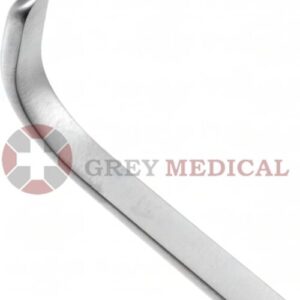Cottle Elevator: A Precision Tool for Nasal and Facial Surgeries
The Cottle Elevator is a specialized surgical instrument widely used in rhinoplasty, septoplasty, and other nasal and facial surgeries. Designed for precision and versatility, the Cottle Elevator serves multiple purposes, including lifting, dissecting, and manipulating tissues with minimal trauma. Its ergonomic design and functionality make it an indispensable tool for surgeons working in delicate and confined anatomical areas.

Design and Features of the Cottle Elevator
The Cottle Elevator is meticulously designed to perform delicate dissection and tissue elevation in nasal and facial surgeries. Its key features include:
1. Dual-Ended Design
The instrument often features two working ends—one flat and broad, and the other narrow and pointed. This dual-ended design provides versatility, allowing surgeons to use the appropriate end depending on the task and anatomical structure.
2. Smooth and Blunt Edges
The working ends of the elevator are smooth and blunt to minimize trauma to surrounding tissues. This design ensures precise manipulation without causing unnecessary damage.
3. Lightweight Construction
The instrument is lightweight and easy to handle, reducing hand fatigue during prolonged procedures. Its slim profile makes it ideal for use in confined spaces, such as the nasal cavity.
4. Surgical-Grade Materials
Crafted from high-quality stainless steel, the Cottle Elevator is durable, corrosion-resistant, and capable of withstanding repeated sterilization. Its polished surface enhances ease of cleaning and prevents tissue adhesion.
Applications of the Cottle Elevator
The Cottle Elevator is a versatile instrument used across various surgical disciplines, particularly in nasal and facial procedures. Its primary applications include:
1. Rhinoplasty
In rhinoplasty (cosmetic or reconstructive nasal surgery), the Cottle Elevator is used to elevate and separate nasal tissues, enabling the surgeon to reshape or reconstruct the nasal structure. Its precision ensures minimal trauma to delicate tissues, improving healing and outcomes.
2. Septoplasty
During septoplasty, the elevator is employed to dissect and lift the mucoperichondrial layer from the nasal septum. This step is critical for correcting deviations or abnormalities in the nasal septum, allowing surgeons to restore proper airflow and nasal function.
3. Sinus Surgery
In sinus surgeries, the Cottle Elevator helps in accessing and elevating tissues around the sinuses. It ensures precise dissection without damaging the surrounding mucosa or other sensitive structures.
4. Facial Plastic Surgery
The elevator is also used in various facial plastic surgeries to lift and manipulate soft tissues, especially in procedures involving the mid-face or nose. Its blunt edges ensure safe dissection in delicate areas.
5. Trauma and Reconstructive Surgery
The Cottle Elevator is commonly utilized in trauma and reconstructive surgeries to elevate fractured bone fragments or separate tissues for proper alignment and healing.
Advantages of the Cottle Elevator
1. Precision and Versatility
The dual-ended design and blunt edges provide surgeons with exceptional precision and versatility, enabling them to perform delicate tasks with ease.
2. Minimal Tissue Trauma
The smooth, blunt ends of the Cottle Elevator reduce the risk of tissue damage, ensuring safer procedures and faster recovery times for patients.
3. Ergonomic Design
The lightweight construction and ergonomic handle make the instrument easy to use, even during lengthy surgeries, reducing hand fatigue for the surgical team.
4. Durability and Reliability
Made from surgical-grade materials, the Cottle Elevator is built to last. Its durability ensures consistent performance even under rigorous use and frequent sterilization.
5. Adaptability
The Cottle Elevator’s ability to perform multiple functions, from tissue dissection to elevation, makes it a highly adaptable tool for various surgical procedures.
Care and Maintenance of the Cottle Elevator
To ensure the longevity and optimal performance of the Cottle Elevator, proper care and maintenance are essential. Follow these guidelines:
1. Cleaning
Clean the elevator thoroughly after each use to remove blood, tissue, and debris. Use appropriate cleaning solutions to prevent staining and corrosion.
2. Sterilization
Sterilize the instrument using standard protocols, such as autoclaving, to eliminate pathogens and maintain hygiene.
3. Inspection
Regularly inspect the instrument for signs of wear, such as dull edges or loose components. Replace or repair the elevator if any damage is detected.
4. Storage
Store the Cottle Elevator in a clean, dry environment, preferably in a designated surgical tray, to protect it from contamination and physical damage.
Conclusion
The Cottle Elevator is an essential instrument in nasal and facial surgeries, offering precision, versatility, and reliability. Its dual-ended design and smooth, blunt edges make it ideal for delicate tissue elevation and dissection, ensuring safe and efficient procedures. Whether used in rhinoplasty, septoplasty, or reconstructive surgeries, the Cottle Elevator plays a critical role in achieving successful surgical outcomes and improving patient care.









